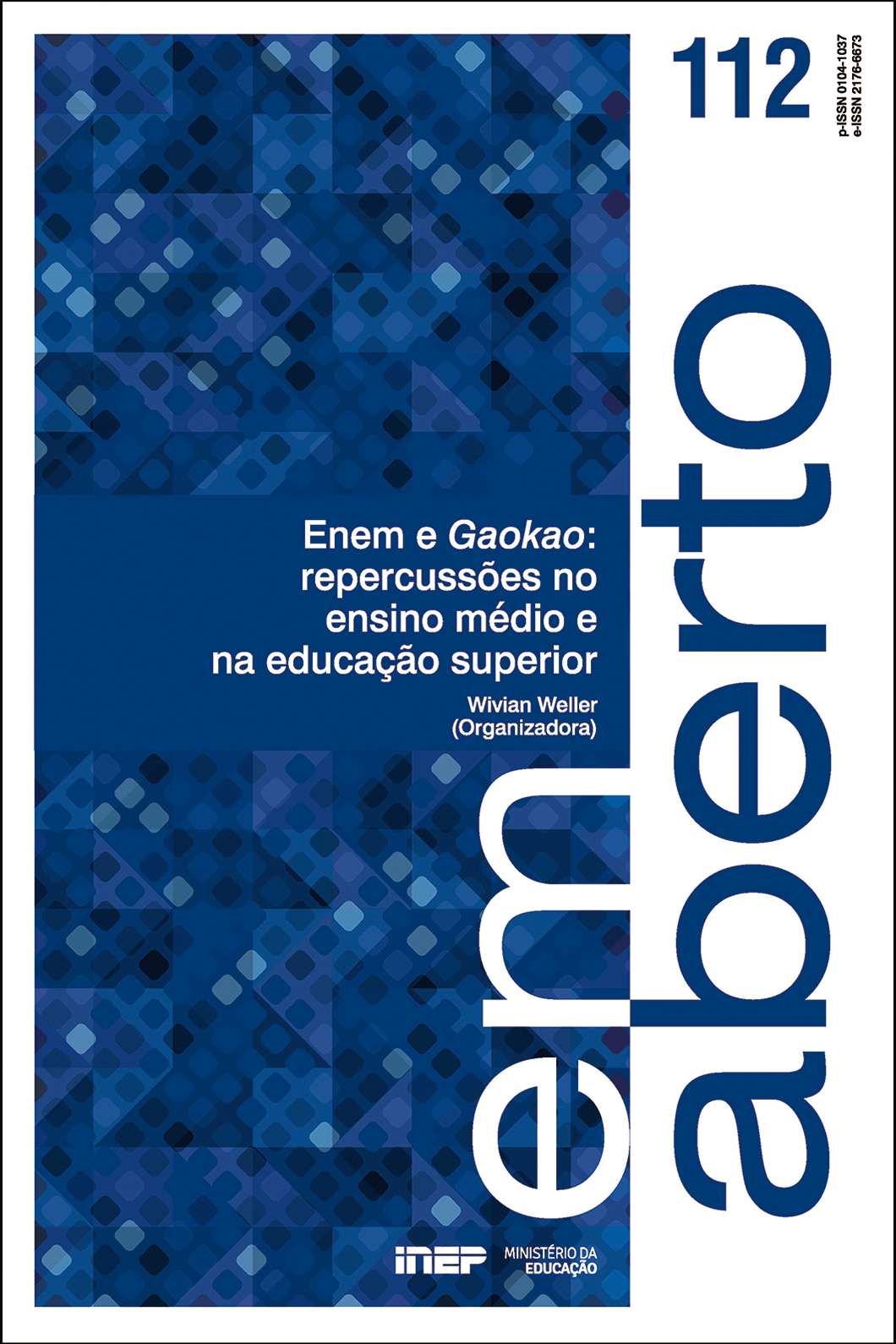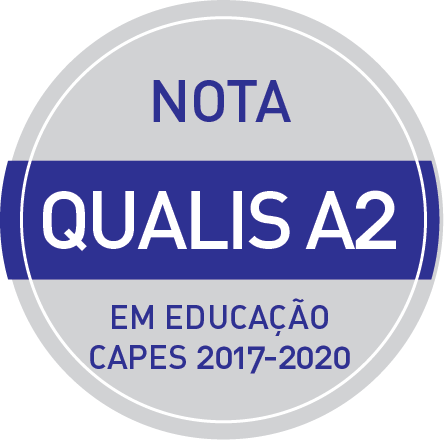Centralized access to higher education: The Enem (Brazil) and Gaokao (China) exams
Abstract
This article analyzes the National College Entrance Examination (Gaokao) and the National High School Exam (Enem), the primary forms of access to higher education in China and Brazil, respectively, and the most substantial large-scale exams in the world in terms of enrollees. This literature review article is supported by the field of comparative education, by its recent trends that favor contextual comparison focused on what can be understood rather than on what can be inferred from a context. It initially discusses the expansion of higher education in both countries since the 1980s, the investments in the constitution of elite universities in China, and the expansion of public universities in Brazil in recent decades. It then addresses the history and development of the exams, the theoretical-methodological, political, and cultural assumptions that guide their organization, the lessons learned, and the challenges that persist in both countries.
Downloads
References
ALVES, A. T. Pai faz Enem para apoiar filho e passa em medicina na BA: ‘a ficha não caiu’. G1 BA [online], 19 jan. 2016. Disponível em: http://g1.globo.com/bahia/noticia/2016/01/pai-faz-enem-para-apoiar-filho-e-passa-em-medicina-na-ba-ficha-nao-caiu.html. Acesso em: 18 fev. 2016.
AMARAL, M. P. Tendências, desafios e potenciais da educação internacional e comparada na atualidade. Revista Brasileira de Estudos Pedagógicos, Brasília, DF, v. 96, n. 243, p. 259-281, maio/ago. 2015.
BRASIL. Lei nº 9.394, de 20 de dezembro de 1996. Estabelece as diretrizes e bases da educação nacional. Diário Oficial da União, Brasília, DF, 23 dez. 1996. Seção 1, p. 27833.
BRASIL. Conselho Nacional de Educação (CNE). Resolução nº 2, de 30 de janeiro de 2012. Define Diretrizes Curriculares Nacionais para o ensino médio. Diário Oficial da União, Brasília, DF, 31 jan. 2012. Seção 1, p. 20.
BRASIL. Instituto Nacional de Estudos e Pesquisas Educacionais Anísio Teixeira (Inep). Censo da Educação Superior: resultados. Brasília, DF, 2020. Disponível em: <https://www.gov.br/inep/pt-br/areas-de-atuacao/pesquisas-estatisticas-e-indicadores/censo-da-educacao-superior/resultados>. Acesso em: 21 dez. 2021.
CAI, Y. et al. Seeking solutions though the mirror of Finnish experience: policy recommendations for regional university transformation in China. Journal of Higher Education Policy and Management, [S. l], v. 37, n. 4, p. 447-458, 2015.
CARNOY, M. et al. Expansão das universidades em uma economia global em mudança: um triunfo dos Bric? Brasília, DF: Capes, 2016.
CHARLESWORTH GROUP. The Charlesworth Group. New Chinese double first class university plan released. [S.l.], 3 Oct. 2017. Available in: https://cwauthors.com/article/double-first-class-list. Access in: 7 Dec. 2021.
CHINA. Ministry of Education (MOE). Reports. Beijing, 2018. Available in: http://en.moe.gov.cn/documents/reports/. Access in: 8 June 2021.
CHINA EDUCATIONAL CENTER. Complete guide to China scholarships: two approaches to study in China on scholarship: higher education in China. [Shanghai, 2019]. Available in: https://www.chinaeducenter.com/en/cedu/hedu.php. Access in: 8 June 2021.
CIAVATTA, M. A formação integrada: a escola e o trabalho como lugares de memória e de identidade. In: FRIGOTTO, G.; CIAVATTA, M.; RAMOS, M. (Org.). Ensino médio integrado: concepções e contradições. São Paulo: Cortez, 2005. p. 83-106.
COSTA, D. M.; ZHA, Q. Chinese higher education: the role of the economy and Projects 211/985 for system expansion. Ensaio: Avaliação e Políticas Públicas em Educação, Rio de Janeiro, v. 28, n. 109, p. 885-908, out./dez. 2020.
CUNHA, C.; CASTRO, S. M. P.; NASCIMENTO, H. M. O ensino médio na nova Constituição. Em Aberto, Brasília, DF, v. 8, n. 41, p. 55-59, jan./mar. 1989.
CUNHA, L. A. O ensino superior no octênio FHC. Educação & Sociedade, Campinas, v. 24, n. 82, p. 37-61, abr. 2003.
CURY, C. R. J. A educação básica no Brasil. Educação & Sociedade, Campinas, v. 23, n. 80, p. 168-200, set. 2002.
DIAS, S. M. Tradição e inovação: perspectivas sobre a educação básica e o ensino médio na China. In: BRASIL. Ministério das Relações Exteriores (MRE). Mundo afora: educação básica e ensino médio. Brasília, DF: MRE, 2014. p. 140-154. v. 11
DUBET, F. O que é uma escola justa? São Paulo: Cortez, 2008.
DWYER, T. Introdução brasileira. In: DWYER, T. et al. (Org.). Jovens universitários em um mundo em transformação: uma pesquisa sino-brasileira. Brasília, DF: Instituto de Pesquisa Econômica Aplicada, 2016. p. 15-35.
DWYER, T. et al. (Org.). Jovens universitários em um mundo em transformação: uma pesquisa sino-brasileira. Brasília, DF: Instituto de Pesquisa Econômica Aplicada, 2016.
GAO, Y. Situação atual e tendência de desenvolvimento do sistema de educação superior da China. In: DWYER, T. et al (Org.). Jovens universitários em um mundo em transformação: uma pesquisa sino-brasileira. Brasília, DF: Instituto de Pesquisa Econômica Aplicada, 2016. p. 43-78.
GONG, F.; LI, J. Seeking excellence in the move to a mass system: institutional responses of key Chinese comprehensive universities. Frontiers of Education in China, [S.l.], v. 5, p. 477-506, 2010.
GU, M.; MA, J.; TENG, J. Portraits of Chinese schools. Singapore: Springer, 2017.
HEGER, I. Coping mit dem Gaokao: Bewältigung, Akzeptanz und Legitimität der chinesischen Hochschulaufnahmeprüfung. In: ALPERMANN, B.; HERRMANN, B.; WIELAND, E. (Org.). Aspekte des sozialen Wandels in China: Familie, Bildung, Arbeit, Identität. Wiesbaden: Springer VS, 2018. p. 73-97.
JING, L. Inequality in public school admission in urban China: discourses, practices and new solutions. Singapore: Springer, 2018.
JUSTINO, R. Estudantes universitários brasileiros e chineses: um estudo comparado dos exames Enem e Gaokao. 2019. 265 f. Tese (Doutorado em Educação) – Faculdade de Educação, Universidade de Brasília, Brasília, DF, 2019.
KAZAMIAS, A. M. Educação comparada: uma reflexão histórica. In: COWEN, R.; KAZAMIAS, A. M.; UNTERHALTER, E. Educação comparada: panorama internacional e perspectivas. Brasília, DF: Unesco; Capes, 2012. p. 173-193.
KHOMYAKOV, M.; DWYER, T.; WELLER, W. Internacionalização da educação superior: excelência ou construção de redes? Do que os países BRICS precisam mais? Sociologias, Porto Alegre, v. 22, n. 54, p. 120-143, maio/ago. 2020.
KIM, D. et al. Building world class universities in China: exploring faculty’s perceptions, interpretations of and struggles with global forces in higher education. Compare: A Journal of Comparative and International Education, [S. l.], v. 48, n. 1, p. 92-109, 2018.
KINGLUN, N. Massification, bureaucratization and questing for “world-class” status: higher education in China since the mid-1990s. International Journal of Educational Management, [S. l.], v. 22, n. 6, p. 547-564, 2008.
LI, C. Educational inequality and educational expansion in China. In: LI, P. et al. (Org.). Handbook on social stratification in the BRIC countries: change and perspective. New Jersey: World Scientific, 2013. p. 569-591.
LI, P. Conclusion: Chinese youth face both opportunities and challenges. In: DWYER, T. et al. (Org.). Handbook of the sociology of youth in BRICS countries. New Jersey: World Scientific, 2018. p. 915-924.
LI, W. Family background, financial constraints and higher education attendance in China. Economics of Education Review, [S. l.], v. 26, n. 6, p. 724-734, Dec. 2007.
LING, M. “Bad students go to vocational schools!”: education, social reproduction and migrant youth in urban China. The China Journal, [S. l.], n. 73, p. 108-131, Jan. 2015.
LIU, Q.; TURNER, D.; JING, X. The “double first-class initiative” in China: background, implementation, and potential problems. Beijing International Review of Education, [S. l.] v. 1, n. 1, p. 92-108, 2019.
LIU, X. The “Double First Class” initiative under top-level design. ECNU Review of Education, [S.l.], v. 1, n. 1, p. 147-152, 2018.
LIU, Y. Higher education, meritocracy and inequality in China. [S.l.]: Springer, 2016.
LU, P. A study of Chinese elite universtity students and graduates. In: DWYER, T. et al. (Org.). Handbook of the Sociology of Youth in BRICS Countries. New Jersey: World Scientific, 2018. p. 589-606.
MARTINS, C. B. O ensino superior brasileiro nos anos 90. São Paulo em Perspectiva, São Paulo, v. 14, n. 1, p. 41-60, mar. 2000.
MOURA, C. P. O “velho” hukou na “nova” China urbana: reflexões sobre uma dualidade contemporânea. Anuário Antropológico, Brasília, DF, v. 38, n. 2, p. 225-245, 2013.
MUTHANNA, A.; SANG, G. Undergraduate Chinese students’ perspectives on Gaokao examination: strengths, weaknesses, and implications. International Journal of Research Studies in Education, [S. l.], v. 5, n. 2, p. 3-12, 2016.
PAUTASSO, D. O lugar da China no comércio exterior brasileiro. Meridiano 47, Brasília, DF, v. 11, n. 114, p. 25-27, jan. 2010.
PETERS, M. A.; BESLEY, T. China’s double first-class university strategy. Educational Philosophy and Theory, v. 50, n. 12, p. 1075-1079, 2018.
RAMOS, M. N. O projeto unitário de ensino médio sob os princípios do trabalho, da ciência e da cultura. In: FRIGOTTO, G.; CIAVATTA, M. (Org.). Ensino médio: ciência, cultura e trabalho. Brasília, DF: Ministério da Educação, 2004. p. 37-52.
REN, T. A organização do Gaokao em Pequim. [Entrevista]. Pequim: [s.n.], 2019. Mimeografado.
ROCHA, P. D. P.; FERREIRA, M. A publicidade oficial do Enem representada nas mídias: um olhar para o exame como dispositivo educacional. Pro-Posições, Campinas, v. 32, p. 1-31, 2021.
RUAN, J. Guanxi, social capital and school choice in China: the rise of ritual capital. Singapore: Springer, 2016.
SCHRIEWER, J. Aceitando os desafios da complexidade: metodologia de educação comparada em transição. In:
SOUZA, D. B.; MARTÍNEZ, S. A. Educação comparada: rotas de além-mar. São Paulo: Xamã, 2009. p. 63-104.
STATISTA. Number of public colleges and universities in Beijing, China from 2010 to 2020. [S.l., 2020]. Available in: https://www.statista.com/statistics/1139377/china-number-of-universities-in-beijing/. Access in: 14 jun. 2021.
STEINER-KHAMSI, G. Presidential address: the politics and economics of comparison. Comparative Education Review, [S. l.], v. 54, n. 3, p. 323-342, 2010.
STUENKEL, O. BRICS e o futuro da ordem global. São Paulo: Paz e Terra, 2017.
WELLER, W.; HORTA NETO, J. L. The Brazilian education system. In: JORNITZ, S.; AMARAL, M. P. (Org.). The education systems of the Americas. [S. l.]: Springer International Publishing, 2020. v. 1, p. 1-27.
WELLER, W.; CHEN, W.; BASSALO, L. Origem familiar, percursos acadêmicos e projetos de estudantes universitários brasileiros e chineses. In: DWYER, T. et al. (Org.). Jovens universitários em um mundo em transformação: uma pesquisa sino-brasileira. Brasília, DF: Instituto de Pesquisa Econômica Aplicada, 2016, p. 165-191.
WIKIPEDIA. Project 985: notable universities of mainland China. [S.l., 2017]. Available in: https://en.wikipedia.org/wiki/Project_985#/media/File:China_Universities_Map.png. Access in: 14 jun. 2021.
WIKIPEDIA. Project 211. [S.l], 2021. Available in: https://www.duhocchina.com/wiki/en/211_Project. Access in: 20 jun. 2021.
YAN, C. “We can’t change much unless the exams change”: teachers’ dilemmas in the curriculum reform in China. Improving Schools, [S. l.] v. 18, n. 1, p. 5-19, 2015.
YANG, X.; YOU, Y. How the world-class university project affects scientific productivity? Evidence from a survey of faculty members in China. Higher Education Policy, [S. l.], v. 31, n. 4, p. 583-605, Nov. 2018.
YE, S.; HONGWEI, B. Gaokao 2020 ends with over 10 million taking apart. In: CGTN. Education. [Beijing], 10 Jul. 2020. Available in: https://news.cgtn.com/news/2020-07-10/Gaokao-2020-ends-with-over-10-million-taking-apart-S0Ytldcvio/index.html. Access in: 14 jun. 2021.
ZONG, X.; ZHANG, W. Establishing world-class universities in China: deploying a quasi-experimental design to evaluate the net effects of Project 985. Studies in Higher Education, [S. l.], v. 44, n. 3, p. 417-431, 2017.
Copyright (c) 2021 Em Aberto

This work is licensed under a Creative Commons Attribution-NonCommercial 4.0 International License.
These are the terms of this Copyright Notice:
- I declare that I permanently forfeit in favor of the National Institute of Educational Studies and Research (INEP) all rights related to:
-
- editing, publication, reproduction, and distribution of the work;
- publication through digital and electronic media;
- translation of the work to any language;
- updating, re-printing, adaptation, and compression of the work;
- uploading of work in the publishing platform of INEP;
- divulging complete or parts of work through the World Wide Web (internet), whether in Brazil or foreign countries;
- authorization of third parties to execute any of the acts mentioned before.
- I explicitly declare that I am solely responsible for the opinions expressed in the work, and its publication does not violate the rights of third parties.
- I declare that the nature of said work is one of pro bono publico and, as such, I forfeit the right to any compensation regarding ownership rights granted.
- I authorize spelling and grammatical review of the manuscript, provided that the content and opinions therein remain unchanged.












